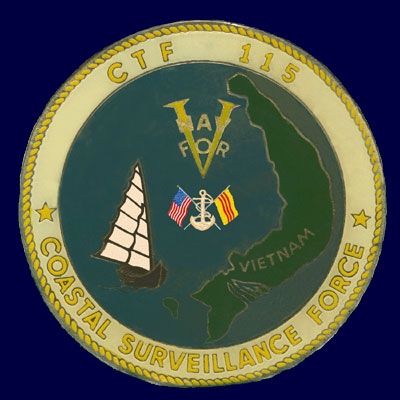|
Coastal Interdiction
The primary objective of the Market Time coastal
patrol was to prevent the enemy from strengthening his forces in South Vietnam through
seaborne infiltration of supplies and munitions. The North Vietnamese Naval
Transportation Group 125 used steel-hulled, 100-ton trawlers and seagoing junks to
infiltrate the South. The Viet Cong operated smaller junks, sampans, and other craft
within South Vietnamese coastal waters, and limiting this movement also became a
responsibility of the Market Time forces.
The coastal surveillance operation was organized
around nine (initially eight) patrol sectors covering the 1,200-mile South Vietnamese
coast from the 17th parallel to the Cambodian border and extending 40 miles out to sea.
Within these areas, ships and craft of the U.S. Navy searched for contraband. American
aircraft operating from ships offshore and from bases in South Vietnam, Thailand, and the
Philippines flew search patterns over the Market Time area. By 1968 the patrol generally
was divided into three zones: (1) an air surveillance sector farthest out to sea; (2) an
outer surface barrier patrolled by large U.S. ships; and (3) an inner, or shallow-water,
barrier patrolled by U.S. and South Vietnamese boats and craft and Coastal Force junks.
Mobile units of Inshore Undersea Warfare Surveillance Group 1, Western Pacific Detachment,
deployed to South Vietnam in April 1966 to form an additional screen.
|
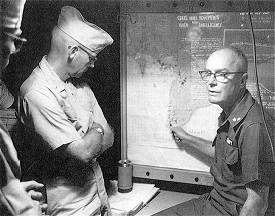 |
|
Rear Admiral Norvell G. Ward, Chief of the Naval Advisory Group and the first Commander of Naval Forces, Vietnam,
discusses with his staff the Communist seaborne infiltration into the Ca Mau Peninsula at the far southern tip of South Vietnam.
|
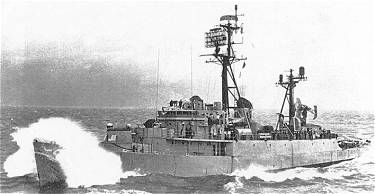 |
|
Radar picket excort ship USS Lowe (DER 325) makes way
with difficulty while patrolling part of South Vietnam's 1,200-mile coast. |
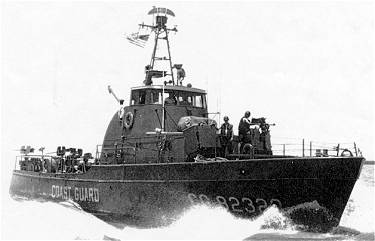 |
|
A U.S. Coast Guard WPB 82-foot cutter, one of 26 deployed to Vietnam, cuts through
the sea in search of Communist vessels. |
|
Market Time forces aided the allied cause in other ways. The naval gunfire support offered by
these American and Vietnamese ships and craft often was of vital importance to ground units
locked in combat. The naval units also served as blocking forces in encirclement operations
conducted near the coast and on large rivers. The transportation of friendly troops and the
evacuation of civilians constituted other important tasks. And, as with most American forces
in South Vietnam, the Market Time units worked to win friends for the allied cause by building
schools, donating food and clothing, and performing other civic actions.
During the first half of 1965, the Seventh Fleet
operationally controlled the Vietnam Patrol Force (Task Force 71), the American component
of Market Time. The Naval Advisory Group, headquartered in Saigon, served as the liaison
between the fleet, COMUSMACV, and the South Vietnamese Navy. The five U.S.-Vietnamese
coastal surveillance centers set up at Danang, Qui Nhon, Nha Trang, Vung Tau, and An
Thoi coordinated actual operations. To improve mutual understanding and communication, U.S. and
Vietnamese naval officers sailed in the vessels of the other service.
|
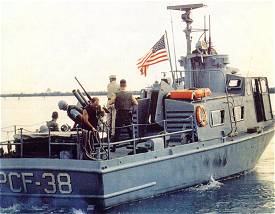 |
|
Workhorse of the Market Time patrol, the 50-foot Swift
fast patrol craft (PCF), armed with .50-caliber machine guns and an 81-millimeter mortar
and capable of 28 knot speeds, formed the core of the Navy's Coastal Surveillance Force.
| |
 |
|
The austere Swift boat base at An Thoi on isolated Phu
Quoc Island off South Vietnam's southwestern coast.
|
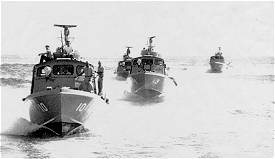 |
|
Boat Division 101, redesignated Coastal Division 11 in
January 1967, based at An Thoi sorties into the Gulf of Siam.
|
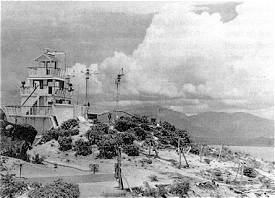 |
|
The harbor entrance control post at Cam Ranh Bay. This
facility, and others like it at Vung Tau, Qui Nhon, Nha Trang, and Vung Ro, directed allied port security. |
|
On 31 July 1965, formal control of
the American Market Time force passed from the Seventh Fleet to the Naval Advisory Group,
which in turn activated the Coastal Surveillance Force (Task Force 115). The fleet
continued to provide logistic and administrative support. The command function was further
refined on 1 April 1966 when Naval Forces, Vietnam, was established, relieving the NAG of
responsibility for Market Time operations. In addition, the naval support activities at
DaNang and Saigon took over logistic and administrative duties. The next year, in July,
Commander Task Force 115 moved his headquarters from Saigon to Cam Ranh Bay.
The years 1965 to 1968 witnessed a great increase
in Market Time resources and the full development of patrol tactics and operating
procedures. During the first months of the patrol in 1965 an average of 15 destroyers or
minesweepers steamed off South Vietnam, with a least one ship assigned to each of the
sectors. Soon, however, radar picket escorts (DER), with better fuel efficiency and
electronic equipment, replaced the destroyers. Furthermore, to help the Vietnamese Navy's
Coastal Force and Sea Force (American naval leaders were dissatisfied with their
operational performance), in June the U.S. coast Guard began dispatching 82-foot cutters
(WPB), eventually totaling 26, to Southeast Asia. The operational chain of command
extended from Commander Task Force 115 through Commander Coast Guard Activities, Vietnam
(established on 3 February 1967) to Coast Guard Squadron 1. This latter command controlled
Coast Guard Division 11 stationed at An Thoi, Coast Guard Division 12 at Danang, and Coast
Guard Division 13 at Cat Lo. To augment the inshore patrol, the Navy bought 84 Swift (PCF)
boats designed by the Louisiana-based Stewart Seacraft Company and deployed them to South
Vietnam. These 50-foot, 23-knot vessels, armed with .50-caliber machine guns and an
81-millimeter mortar, became the mainstays of the Navy's Coastal Surveillance Force. Under
Boat Squadron 1 (later Coastal Squadron 1), Boat Division 101-105 (redesignated Coastal
Divisions 11-15 on 1 January 1967) operated from bases at An Thoi, Danang, Cat Lo, Cam
Ranh Bay, and Qui Nhon, respectively. In June 1967 the Navy activated an additional Swift
boat unit, Coastal Division 16, at Chu Lai in I Corps.
The harbor defense and surveillance units in the
ports of Vung Tau, Cam Ranh Bay, Qui Nhon, Nha Trang, and Vung Ro, Inshore Undersea
Warfare Groups (IUWG) 1, 2, 3, 4, and 5, operated a total of 16 large personnel landing
craft, 25 Boston Whalers, and 8 picket boats in Operation Stable Door. The 45-foot picket
boats, which began to reach Vietnam in June 1967, carried a crew of one officer and five
men and two .50-caliber machine guns, twin-mounted. In each port the units constructed
harbor entrance control posts and equipped them with radios and surface search radars.
During 1967 and 1968, the continuing demand for
Market Time vessels resulted in the deployment of 15 Coast Guard high endurance cutters
(WHEC) to South Vietnam. Operating under Coast Guard Squadron 3, activated with the first
deployments in the spring of 1967, the WHECs added their search radars, one
5-inch/38-caliber gun, six .50-caliber machine guns, and two 81-millimeter mortars to the
patrol's firepower.
Beginning in 1967, the newly built Asheville-class
patrol gunboat (PG), designed specifically for coastal operations in the Third World, made
its first appearance in Southeast Asia. That March, Commander Coastal Squadron 3 began
surveillance of South Vietnam's coast with Gallup (PG 85). Coastal Flotilla 1 was
then created to direct the operations of this unit and the new Coastal Squadron 1, with Asheville
(PG 84) and Crockett (PG 88). The 165-foot PGs capable of 37-knot speeds, carried
one 3-inch/.50-caliber gun forward, one 40-millimeter gun aft, and four .50-caliber
machine guns. At first Plagued by mechanical and repair part replacement problems, the
shallow-draft and well-armed PGs became a useful Market Time resource. But hydrofoil
gunboats Flagstaff (PGH 1) and Tucumcari (PGH 2), assigned to Task Force
115 later in the war, proved not as satisfactory in operation. These revolutionary vessels
were unsuited to patrols in the rough seas off Vietnam and were too mechanically complex
for the repair facilities in the combat theater.
|
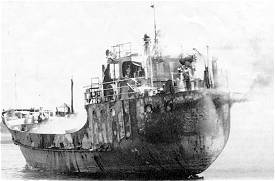 |
|
Smoke billows forth from a North Vietnamese trawler run aground
by the Market Time patrol forces.
|
|
Various aircraft flew aerial
surveillance of South Vietnam's coastal waters. For a brief time in 1965 A-1 Skyraiders
operating from carriers at Dixie Station covered the central Vietnam coast. This mission
was shared and then taken over by a patrol squadron based at Sangley Point in the
Philippines and equipped with the advanced P-3 Orion aircraft. Throughout this period,
five to seven P-2 Neptunes stationed at Tan Son Nhut near Saigon ranged up and down the
South Vietnamese littoral along designated patrol tracks. In addition, from May 1965 to
April 67, Martin P-5 Marlin seaplanes operated from seaplane tenders Currituck
(AV 7) and Salisbury Sound (AV 13), periodically anchored at Condore and Cham
islands and at Cam Ranh Bay. To compensate for withdrawal of the older seaplanes in early
1967, the Navy stationed a squadron of 12 P-2's ashore at Cam Ranh Bay and a detachment of
P-3's at Utapao in Thailand. The P-3s patrolled the Gulf of Siam. On an intermittent
basis, U.S. Army Bird Dog observation aircraft and South Vietnamese Douglas C-47s watched
over several critical coastal sectors.
To improve the effectiveness of the anti-infiltration system, the Navy emplaced
surface search radars on Son and Obi islands south of the Mekong Delta and on Re island
east of Chu Lai and upgraded communications between headquarters, coastal surveillance
centers surface ships and craft, and aircraft. Greater use of junks and sampan identification
manuals, South Vietnamese identity papers, and passes for fishermen tightened the coastal net.
MACV intelligence also focused more attention on the Communist maritime effort.
There was scant evidence in 1965 of Communist seaborne infiltration. After the Vung Ro
incident in February, the allies detected not one trawler closing the shore. Relatively few of
the junks and smaller craft stopped and searched in shallow water were found to carry enemy
personnel or contraband. During this period, however, the patrol was not functioning with
maximum effectiveness because the Americans and the South Vietnamese concentrated on refining
patrol responsibilities, search sectors, operational tactics, command and communications procedures,
and other essential matters. Furthermore, while the number of vessels in the command increased, the
total still was insufficient for complete coverage of South Vietnam's coastal waters.
|
|
